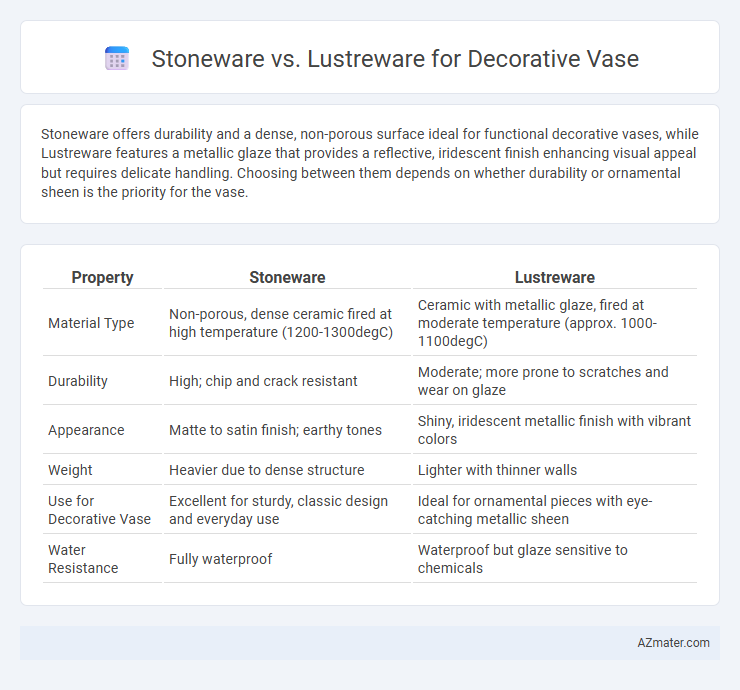Stoneware offers durability and a dense, non-porous surface ideal for functional decorative vases, while Lustreware features a metallic glaze that provides a reflective, iridescent finish enhancing visual appeal but requires delicate handling. Choosing between them depends on whether durability or ornamental sheen is the priority for the vase.
Table of Comparison
| Property | Stoneware | Lustreware |
|---|---|---|
| Material Type | Non-porous, dense ceramic fired at high temperature (1200-1300degC) | Ceramic with metallic glaze, fired at moderate temperature (approx. 1000-1100degC) |
| Durability | High; chip and crack resistant | Moderate; more prone to scratches and wear on glaze |
| Appearance | Matte to satin finish; earthy tones | Shiny, iridescent metallic finish with vibrant colors |
| Weight | Heavier due to dense structure | Lighter with thinner walls |
| Use for Decorative Vase | Excellent for sturdy, classic design and everyday use | Ideal for ornamental pieces with eye-catching metallic sheen |
| Water Resistance | Fully waterproof | Waterproof but glaze sensitive to chemicals |
Introduction to Stoneware and Lustreware Vases
Stoneware vases are crafted from dense, durable clay fired at high temperatures, resulting in a sturdy, non-porous surface ideal for long-lasting decorative pieces. Lustreware vases, characterized by their iridescent metallic glaze, offer a unique, reflective finish achieved through a specialized firing process that produces a shimmering, elegant appearance. Both stoneware and lustreware vases provide distinct aesthetic qualities, with stoneware excelling in robustness and lustreware standing out for its decorative brilliance.
Understanding Stoneware: Features and History
Stoneware is a durable, non-porous ceramic fired at high temperatures between 1200degC and 1300degC, making it ideal for decorative vases due to its strength and water resistance. Originating in ancient China and widely adopted in European pottery traditions, stoneware is valued for its dense, stone-like texture and natural earthy tones. Its versatility allows for various glazing techniques, enhancing aesthetic appeal while preserving functional qualities.
What is Lustreware? Origins and Appeal
Lustreware is a type of pottery characterized by its iridescent metallic glaze achieved through a complex firing process that involves the application of metallic oxides. Originating in the Islamic world during the 9th century and later gaining popularity in Europe during the 18th century, lustreware offers a shimmering finish that enhances the visual appeal of decorative vases. Its unique reflective quality and historical significance make lustreware a prized choice for collectors and designers seeking both aesthetic beauty and cultural depth.
Visual Differences Between Stoneware and Lustreware
Stoneware decorative vases exhibit a matte or semi-matte finish with earth-toned, rustic textures characterized by their dense, durable clay body. Lustreware vases showcase a metallic, iridescent sheen achieved through a distinctive glazing technique that produces reflective, shiny surfaces often highlighted with vibrant, shimmering colors. The visual contrast lies in stoneware's understated, natural appearance versus lustreware's glossy, luminous brilliance that enhances its decorative appeal.
Durability and Practical Use: Stoneware vs Lustreware
Stoneware offers superior durability due to its high firing temperature, making it resistant to chipping and ideal for everyday use in decorative vases. Lustreware, characterized by its metallic sheen, is more fragile and prone to wear, best suited for display rather than heavy handling. Choosing stoneware ensures long-lasting functionality while lustreware emphasizes aesthetic appeal with limited practical use.
Artistic Techniques Used in Stoneware and Lustreware
Stoneware vases showcase artistic techniques such as high-temperature firing and salt glazing, resulting in durable, earthy textures that highlight natural clay tones and intricate surface details. Lustreware vases employ metallic oxide glazes that create a shimmering, iridescent finish through a reduction firing process, enhancing decorative patterns with reflective, jewel-like qualities. Both techniques emphasize craftsmanship, but stoneware focuses on robust, tactile aesthetics, while lustreware prioritizes luminous, decorative brilliance.
Price Comparison: Investment Value for Collectors
Stoneware vases typically offer greater durability and a more substantial feel, often priced higher due to their robust material and artisanal craftsmanship, appealing to collectors seeking long-term investment value. Lustreware vases, known for their iridescent glaze and delicate finish, usually come at a premium price reflecting their aesthetic appeal and rarity but may require more careful handling to maintain condition. Collectors evaluating price comparison prioritize stoneware for resilience and consistent value retention, while lustreware can command higher prices influenced by unique artistic qualities and market trends.
Best Uses: Where Each Style Shines in Home Decor
Stoneware vases offer durability and warmth, making them ideal for rustic or farmhouse-style decor, perfect for high-traffic areas or outdoor spaces where sturdiness is essential. Lustreware vases shine in elegant or contemporary interiors with their reflective, metallic glaze, serving as eye-catching statement pieces on mantelpieces or decorative shelves. Stoneware excels in functional use with its earthy texture, while lustreware focuses on visual appeal through its glossy finish.
Maintenance and Longevity of Stoneware vs Lustreware Vases
Stoneware vases offer superior durability and resistance to chipping, making them ideal for long-term decorative use with minimal maintenance. Lustreware vases, characterized by their delicate metallic glaze, require careful handling and gentle cleaning to preserve their iridescent finish, which can wear off over time if exposed to harsh conditions. The robust, non-porous nature of stoneware ensures it retains its structural integrity and appearance better than lustreware in everyday environments.
Choosing the Right Decorative Vase: Stoneware or Lustreware?
Stoneware offers durability and a rustic, matte finish ideal for a sturdy decorative vase that complements natural and earthy interiors. Lustreware features a metallic, iridescent glaze that creates a striking, reflective surface suitable for adding a vibrant, artistic statement in modern or eclectic decor. Choosing between stoneware and lustreware depends on balancing aesthetic preferences with functional durability and the vase's intended decorative impact.

Infographic: Stoneware vs Lustreware for Decorative vase
 azmater.com
azmater.com